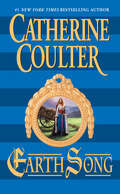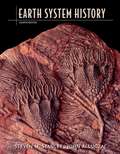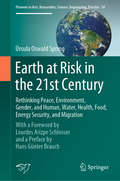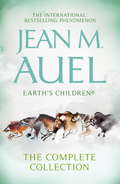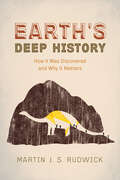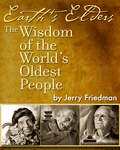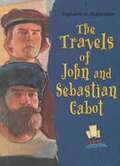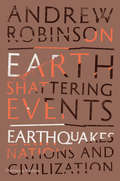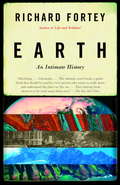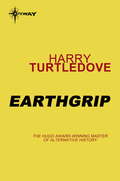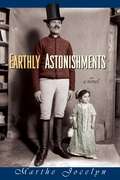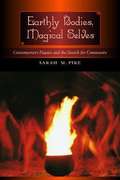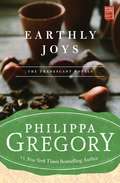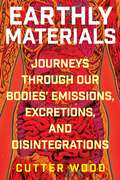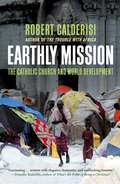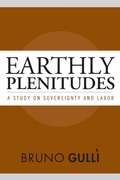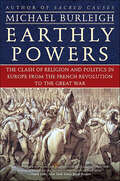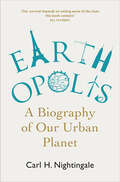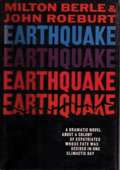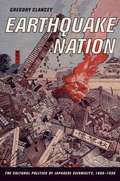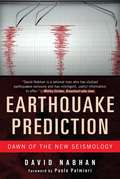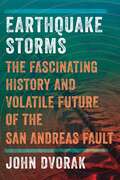- Table View
- List View
Earth Song (Medieval Song Quartet #3)
by Catherine CoulterDear Reader: Philippa de Beauchamp, as impulsive as she is beautiful, flees her father's castle when she hears she is to be wed to the repellent Baron de Bridgport. But her daring escape in a wool wagon quickly becomes a misadventure, and she winds up in the arms of Dienwalk de Fortenberry, a rogue as smooth and bold as Aquitaine wine. Soon Philippa finds herself a prisoner at Dienwald's castle, where there are mysteries to be solved, villians to be bested, and a stubborn man's heart to be won. You'll also meet old friends, Graelam and Kassia de Moreton from Fire Song, as well as the king of England, who is closesr to Philippa than she could ever imagine. Journey back to the thirteenth-century Cornwall, and let me entertain you.
Earth System History (Fourth Edition)
by Steven M. Stanley John A. LuczajThe thoroughly updated new edition includes important new coverage on mass extinctions, climate change, and Proterozoic history, plus a range of interactive studying and teaching tools.
Earth and Its People: A Global History (AP edition)
by Daniel R. Headrick Pamela Kyle Crossley Richard W. Bulliet Lyman L. Johnson David Northrup Steven W. HirschThe book explores the common challenges and experiences that unite the human past.
Earth at Risk in the 21st Century: With a Foreword by Lourdes Arizpe Schlosser and a Preface by Hans Günter Brauch (Pioneers in Arts, Humanities, Science, Engineering, Practice #18)
by Úrsula Oswald SpringEarth at Risk in the 21st Century offers critical interdisciplinary reflections on peace, security, gender relations, migration and the environment, all of which are threatened by climate change, with women and children affected most. Deep-rooted gender discrimination is also a result of the destructive exploitation of natural resources and the pollution of soils, water, biota and air. In the Anthropocene, the management of human society and global resources has become unsustainable and has created multiple conflicts by increasing survival threats primarily for poor people in the Global South. Alternative approaches to peace and security, focusing from bottom-up on an engendered peace with sustainability, may help society and the environment to be managed in the highly fragile natural conditions of a ‘hothouse Earth’. Thus, the book explores systemic alternatives based on indigenous wisdom, gift economy and the economy of solidarity, in which an alternative cosmovision fosters mutual care between humankind and nature.• Special analysis of risks to the survival of humankind in the 21st century.• Interdisciplinary studies on peace, security, gender and environment related to global environmental and climate change.• Critical reflections on gender relations, peace, security, migration and the environment• Systematic analysis of food, water, health, energy security and its nexus.• Alternative proposals from the Global South with indigenous wisdom for saving Mother Earth.
Earth's Children Omnibus
by Jean M. AuelA true publishing phenomenon, Jean M. Auel's prehistoric odyssey is one of the best-loved sagas of our time. Leave 21st century London and go back to Ice Age Europe. Follow Ayla, a Cro-Magnon child who loses her parents in an earthquake and is adopted by a tribe of Neanderthal, the Clan. See how the Clan's wary suspicion is gradually transformed into acceptance of this girl, so different from them, under the guidance of its medicine woman Iza and its wise holy man Creb. Immerse yourself in a world dictated by the demands of survival in a hostile environment, and be swept away in an epic tale of love, identity and struggle.All six parts of the legendary Earth's Children® series are brought together in this eBook omnibusTHE CLAN OF THE CAVE BEARTHE VALLEY OF HORSESTHE MAMMOTH HUNTERSTHE PLAINS OF PASSAGETHE SHELTERS OF STONETHE LAND OF PAINTED CAVESJean Auel combines her brilliant narrative skills and appealing characters with a remarkable re-creation of the way life was lived thousands of years ago, rendering the terrain, dwelling places, longings, beliefs, creativity and daily lives of Ice Age Europeans as real to the reader as today's news.'Among modern epic spinners, Auel has few peers.' - Kirkus Reviews
Earth's Deep History: How It Was Discovered and Why It Matters
by Martin J. RudwickEarth has been witness to mammoths and dinosaurs, global ice ages, continents colliding or splitting apart, comets and asteroids crashing catastrophically to the surface, as well as the birth of humans who are curious to understand it all. But how was it discovered? How was the evidence for it collected and interpreted? And what kinds of people have sought to reconstruct this past that no human witnessed or recorded? In this sweeping and magisterial book, Martin J. S. Rudwick, the premier historian of the earth sciences, tells the gripping human story of the gradual realization that the Earth's history has not only been unimaginably long but also astonishingly eventful. Rudwick begins in the seventeenth century with Archbishop James Ussher, who famously dated the creation of the cosmos to 4004 BC. His narrative then turns to the crucial period of the late eighteenth and early nineteenth centuries, when inquisitive intellectuals, who came to call themselves "geologists," began to interpret rocks and fossils, mountains and volcanoes, as natural archives of Earth's history. He then shows how this geological evidence was used--and is still being used--to reconstruct a history of the Earth that is as varied and unpredictable as human history itself. Along the way, Rudwick defies the popular view of this story as a conflict between science and religion and reveals that the modern scientific account of the Earth's deep history retains strong roots in Judaeo-Christian ideas. Extensively illustrated, Earth's Deep History is an engaging and impressive capstone to Rudwick's distinguished career. Though the story of the Earth is inconceivable in length, Rudwick moves with grace from the earliest imaginings of our planet's deep past to today's scientific discoveries, proving that this is a tale at once timeless and timely.
Earth's Elders
by Jerry FriedmanIn the creation of Earth's Elders, Jerry Friedman met, interviewed and photographed some of the world's oldest elders - 110 years old or older (supercentenarians, as researchers call them).Jerry Friedman, photographer, author and founder of Earth's Elders, spent four years on a landmark project to introduce the world to the sixty oldest people on earth. Using his lens to capture a community that has never before been documented, the award-winning photographer has shed new light on the "invisible" world of people 110 years and older.With each visit on his globetrotting journey to capture the lives of these "super centenarians," Friedman gained a deeper understanding of what the elderly in every culture have to offer. Inspired by the opportunity to improve the quality of life of the elderly, to teach children to recognize the wisdom and value of the elderly as essential parts of our society, and to improve the health of our communities through intergenerational tolerance and communication, Friedman created Earth's Elders.
Earth's Explorers: John And Sebastian Cabot
by Joanne MatternLong-ago adventures are still a thrill in these vividly illustrated titles. These exciting tales of the quest for wealth and land describe the routes taken by famous explorers, the hardships they endured, and the rewards they reaped. Titles also address the impact these explorations made on the native inhabitants of conquered lands.
Earth-Shattering Events: Earthquakes, Nations, and Civilization
by Andrew Robinson"A truly welcome and refreshing study that puts earthquake impact on history into a proper perspective." --Amos Nur, Emeritus Professor of Geophysics, Stanford University, California, and author of Apocalypse: Earthquakes, Archaeology, and the Wrath of God Since antiquity, on every continent, human beings in search of attractive landscapes and economic prosperity have made a Faustian bargain with the risk of devastation by an earthquake. Today, around half of the world’s largest cities – as many as sixty – lie in areas of major seismic activity. Many, such as Lisbon, Naples, San Francisco, Teheran, and Tokyo, have been severely damaged or destroyed by earthquakes in the past. But throughout history, starting with ancient Jericho, Rome, and Sparta, cities have proved to be extraordinarily resilient: only one, Port Royal in the Caribbean, was abandoned after an earthquake. Earth-Shattering Events seeks to understand exactly how humans and earthquakes have interacted, not only in the short term but also in the long perspective of history. In some cases, physical devastation has been followed by decline. But in others, the political and economic reverberations of earthquake disasters have presented opportunities for renewal. After its wholesale destruction in 1906, San Francisco went on to flourish, eventually giving birth to the high-tech industrial area on the San Andreas fault known as Silicon Valley. An earthquake in Caracas in 1812 triggered the creation of new nations in the liberation of South America from Spanish rule. Another in Tangshan in 1976 catalysed the transformation of China into the world’s second largest economy. The growth of the scientific study of earthquakes is woven into this far-reaching history. It began with a series of earthquakes in England in 1750. Today, seismologists can monitor the vibration of the planet second by second and the movement of tectonic plates millimeter by millimeter. Yet, even in the 21st century, great earthquakes are still essentially "acts of God," striking with much less warning than volcanoes, floods, hurricanes, and even tornadoes and tsunamis.
Earth: An Intimate History
by Richard ForteyIn Earth, the acclaimed author of Trilobite! and Life takes us on a grand tour of the earth's physical past, showing how the history of plate tectonics is etched in the landscape around us. Beginning with Mt. Vesuvius, whose eruption in Roman times helped spark the science of geology, and ending in a lab in the West of England where mathematical models and lab experiments replace direct observation, Richard Fortey tells us what the present says about ancient geologic processes. He shows how plate tectonics came to rule the geophysical landscape and how the evidence is written in the hills and in the stones. And in the process, he takes us on a wonderful journey around the globe to visit some of the most fascinating and intriguing spots on the planet. From the Trade Paperback edition.
Earthgrip
by Harry TurtledoveJennifer Logan was young, gorgeous, and utterly dedicated to teaching middle English. But to qualify for any decent teaching position, she'd have to make her résumé stand out. Since her specialty was science fiction, she wrangled a berth on a trading ship bound for the stars. Just one trip, she figured, then back to a nice, safe classroom . . . But Jennifer hadn't fully appreciated her own talent. She had a keen eye, a fresh perspective-and all of science fiction to fall back on when the going got tough!
Earthly Astonishments
by Marthe JocelynIn the late nineteenth century, in a dot of a town called Westley, lives the smallest girl in the world. Josephine stands only twenty-two inches high and her parents charge gawkers a penny a piece to see her - until they realize that the headmistress of MacLaren Academy for Girls will pay even more.At the Academy Josephine is treated like a slave and is tormented by the fine young ladies who attend, until she takes five gold dollars and runs away. She finds a new life with R. J. Walters' Museum of Earthly Astonishments. Among the other human curiosities in the Coney Island freak show, Josephine finds the family she has never known...and dangers greater than any she'd ever dreamed.This riveting novel of adventure and injustice, new in paperback, has received many honors, including selection as a finalist for the Canadian Library book of the Year for Children Award, and as a shortlisted title for the Hackmatack Children's Choice Book Award and the Red Cedar Book Award.From the Hardcover edition.
Earthly Bodies, Magical Selves: Contemporary Pagans and the Search for Community
by Sarah M. PikeThis book is the first ever comprehensive study of neo-pagans and modern day neo-pagan festivals. Neo-paganism is the latest of new religions to emerge on the scene, its popularity growing in both Europe and North America as followers attempt to wed environmental concerns with traditional spirituality.
Earthly Bounties
by L. E. ThomasIn the bucolic late 18th Century English countryside, the Reverend Tobias Whitmore, Vicar of St. Margaret’s, is happily settled with his lovely wife Lucy and their baby son Jamie. However, a chance trip for the couple to the genteel spa town of Bath provides up all sorts of unexpected opportunities for romps and frolics, to Tobias’ eternal surprise.The Whitmores’ dear friend Meg is out of sorts and unsure of direction in her prosperous life as a medium-grade courtesan. Her visit away to distract herself from her megrims takes to her to the seafaring city of Bristol to reunite with her good friend Betty. She also attracts the admiration of Merchant Seaman Alex Marriott. But is Alex all he seems? And should Meg risk her secure existence all on the dice of romance?
Earthly Joys: A Novel (Earthly Joys #1)
by Philippa Gregory#1 New York Times bestselling author and "queen of royal fiction" (USA TODAY) Philippa Gregory brings to life the passionate, turbulent times of seventeenth-century England as seen through the eyes of the country's most famous royal gardener.John Tradescant's fame and skill as a gardener are unsurpassed in seventeenth-century England, but it is his clear-sighted honesty and loyalty that make him an invaluable servant. As an informal confidant of Sir Robert Cecil, adviser to King James I, he witnesses the making of history, from the Gunpowder Plot to the accession of King Charles I and the growing animosity between Parliament and court. Tradescant's talents soon come to the attention of the most powerful man in the country, the irresistible Duke of Buckingham, the lover of King Charles I. Tradescant has always been faithful to his masters, but Buckingham is unlike any he has ever known: flamboyant, outrageously charming, and utterly reckless. Every certainty upon which Tradescant has based his life--his love of his wife and children, his passion for his work, his loyalty to his country--is shattered as he follows Buckingham to court, to war, and to the forbidden territories of human love.
Earthly Materials: Journeys Through Our Bodies' Emissions, Excretions, and Disintegrations
by Cutter WoodAn “UNEXPECTEDLY PROFOUND,” “DEEPLY STRANGE,” and “UTTERLY UNIQUE tour of the human body” (Publishers Weekly)"A must read for anyone who’s ever been amazed or aghast at what just came out." — Rachel Yoder, author of NightbitchTo live, our bodies must continuously shed materials. Stop urinating, stop defecating, stop expelling breath, and death is near. While we often think of these materials as embarrassing waste products, they serve far more complex functions. The color of our mucus, the volume of our flatus, the rhythm of our breath: taken together, these materials tell a story of the human that produced them. Moreover, the exchange, elimination, and frequent disguise of our effluence has been elemental to the development of human civilization, and our lives today are still governed by a host of laws and superstitions and social mores about the materials our bodies leave behind.In each of twelve discrete chapters, Earthly Materials tells a story about one of the materials the human body sheds—from breath and urine to vomit and tears. Sometimes the questions examined are historical: What have we physically done with all the urine produced in our cities? Sometimes they approach the matter through a philosophical lens: Is it ever logical to cry? Sometimes they explore recent scientific discoveries: How is mucus forcing us to reconsider our understanding of natural selection? But they always offer a window into how we negotiate our place in the world and how we get along with one another. Cutter Wood's delightfully weird, richly informative, and unexpectedly poetic tour of our bodily excretions uncovers extraordinary truths about ourselves--and the human story.
Earthly Mission
by Robert CalderisiWith 1. 2 billion members, the Catholic Church is the worlds largest organization and perhaps its most controversial. The Churchs obstinacy on matters like clerical celibacy, the role of women, birth control, and the child abuse scandal has alienated many Catholics, especially in the West. Yet in Africa, Asia, and Latin America, the Church is highly esteemed for its support of education, health, and social justice. In this deeply informed book, Robert Calderisi unravels the paradoxes of the Catholic Churchs role in the developing world over the past 60 years. Has the Catholic Church on balance been a force for good? Calderisi weighs the Churchs various missteps and poor decisions against its positive contributions, looking back as far as the Spanish Conquest in Latin America and the arrival of missionaries in Africa and Asia. He also looks forward, highlighting difficult issues that threaten to disrupt the Churchs future social role. The authors answer to the question he poses will fascinate Catholic and non-Catholic readers alike, providing a wealth of insights into international affairs, development economics, humanitarian concerns, history, and theology.
Earthly Necessities: Economic Lives In Early Modern Britain (The\new Economic History Of Britain Ser.)
by Keith WrightsonThis lucid and elegantly written book seeks to redefine the economic history of early modern Britain for a new generation of readers. Combining the research of economic historians with the insights provided by recent advances in social and cultural history, Keith Wrightson describes the basic institutions and relationships of economic life, traces the processes of change, and examines how these changes affected men, women, and children at all social levels. Wrightson reemphasizes the significance of the period as a turning point in British economic development, one that included the creation of an integrated market economy, the expansion of capitalist organization and enterprise, and reconfigurations of economic power. He shows how economic practices and priorities were embedded in social relations and how shifts in attitudes, values, and understandings played an essential part in the emergence of a market society. And he compares and contrasts the distinctive experiences of Scotland and Wales with those of England. Novel in its structure, scope, and emphasis on the lived experience of the period, the book vividly demonstrates the gains and costs of economic change.
Earthly Plenitudes: A Study on Sovereignty and Labor
by Bruno GulliA fierce critique of productivity and sovereignty in the world of labor and everyday life, Bruno Gullì’s Earthly Plenitudes asks, can labor exist without sovereignty and without capitalism? He introduces the concept of dignity of individuation to prompt a rethinking of categories of political ontology. Dignity of individuation stresses the notion that the dignity of each and any individual being lies in its being individuated as such; dignity is the irreducible and most essential character of any being. Singularity is a more universal quality. Gullì first reviews approaches to sovereignty by philosophers as varied as Gottfried Leibniz and Georges Bataille, and then looks at concrete examples where the alliance of sovereignty and capital cracks under the potency of living labor. He examines contingent academic labor as an example of the super-exploitation of labor, which has become a global phenomenon, and as such, a clear threat to the sovereign logic of capital. Gullì also looks at disability to assert that a new measure of humanity can only be found outside the schemes of sovereignty, productivity, efficiency, and independence, through care and caring for others, in solidarity and interdependence.
Earthly Powers: The Clash of Religion and Politics in Europe, from the French Revolution to the Great War
by Michael BurleighIn this masterful, stylish, and authoritative book, Michael Burleigh gives us an epic history of the battles over religion in modern Europe, examining the complex and often lethal ways in which politics and religion have interacted and influenced each other over the last two centuries. From the French Revolution to the totalitarian movements of the twentieth century, Earthly Powers is a uniquely powerful portrait of one of the great tensions of modern history—one that continues to be played out on the world stage today.
Earthopolis: A Biography of Our Urban Planet
by Carl H. NightingaleThis is a biography of Earthopolis, the only Urban Planet we know of. It is a history of how cities gave humans immense power over Earth, for good and for ill. Carl Nightingale takes readers on a sweeping six-continent, six-millennia tour of the world's cities, culminating in the last 250 years, when we vastly accelerated our planetary realms of action, habitat, and impact, courting dangerous new consequences and opening prospects for new hope. In Earthopolis we peek into our cities' homes, neighborhoods, streets, shops, eating houses, squares, marketplaces, religious sites, schools, universities, offices, monuments, docklands, and airports to discover connections between small spaces and the largest things we have built. The book exposes the Urban Planet's deep inequalities of power, wealth, access to knowledge, class, race, gender, sexuality, religion and nation. It asks us to draw on the most just and democratic moments of Earthopolis's past to rescue its future.
Earthquake
by Milton Berle John RoeburtTRAPPED IN CUSTOM-MADE GRAVESThere was Stroilov, who preferred suicide to suffocation—or to death by the killer who lurked in the silent blackness.There was Taylor, who gave apologies to no man and who now refused God, vowing even to murder before his last breath.There was Susan, who used her small space beneath the earth as a confession box, daring to speak thoughts that lay stagnant in her mind and blood.And there was Donna, most courageous of all, who struggled alone, delivering her child into a world created to be destroyed...Milton Berle and John Roeburt provide an unforgettable and soul-searching answer in this moving story of a small group of people brought together in a tiny Mexican village at precisely the time an earthquake strikes—and rips their world apart.We ask ourselves—Why? Why that place? Why those people? Which of them is destined to die? And can the lives—and souls—of the survivors ever again be the same?“Taut, nerve-gripping drama, brought off with skill and a sharp eye for the human comedy and the darkness at three o’clock in the morning.”—Stephen Longstreet“A curious book...an interesting chess game”—THE NEW YORK TIMES
Earthquake Nation: The Cultural Politics of Japanese Seismicity, 1868-1930
by Gregory K. ClanceyA cultural history of Japanese earthquakes at the turn of the 20th century and a look at their relationship to matters of modernization. The book synthesizes Japanese architecture, science, technology, labor, and art, while making theoretical contributions to the field of science studies.
Earthquake Prediction: Dawn of the New Seismology
by David NabhanEach year the world faces thousands of earthquakes of magnitude 5.0 or greater, resulting in devastating property destruction and tragic loss of life. To help avert these catastrophes, scientists have long searched for ways to predict when and where earthquakes will happen. The earth science establishment in the US says that earthquake prediction still lies outside the realm of possibility. But recent scientific developments across the globe suggest that seismic forecasting is on the horizon.Earthquake Prediction: Dawn of the New Seismology examines the latest scientific clues in hopes of discovering seismic precursors which may shed light on real earthquake prediction in the future. It is destined to be nothing less than an epoch-changing work, addressing this ancient enigma by joining the parts of a scientific detective story that ranges from the steppes of Russia to the coast of Chile, bringing to light astounding breakthroughs by researchers in Italy, India and elsewhere. Governments in countries such as China and Japan provide support for seismic forecasting, and it is time for our country to do the same. Earthquake Prediction makes the case, with an important message for the tens of millions of Americans on the US West Coast, the Mississippi River Valley, and other seismically active zones.
Earthquake Storms
by John Dvorak&“Dvorak has done earthquake science sterling service by writing what is unarguably the best, the most comprehensive and compellingly readable book about the great fault, America's 800 mile long seismic danger zone, that will one day affect all of our lives.&”—Simon Winchester, New York Times Bestselling author of The Crack at the Edge of the World and KrakatoaIt is a prominent geological feature that is almost impossible to see unless you know where to look. Hundreds of thousands of people drive across it every day. The San Andreas Fault is everywhere, and primed for a colossal quake. For decades, scientists have warned that such a sudden shifting of the Earth's crust is inevitable. In fact, it is a geologic necessity.The San Andreas fault runs almost the entire length of California, from the redwood forest to the east edge of the Salton Sea. Along the way, it passes through two of the largest urban areas of the country - San Francisco and Los Angeles. Dozens of major highways and interstates cross it. Scores of housing developments have been planted over it. The words "San Andreas" are so familiar today that they have become synonymous with earthquake.Yet, few people understand the San Andreas or the network of subsidiary faults it has spawned. Some run through Hollywood, others through Beverly Hills and Santa Monica. The Hayward fault slices the football stadium at the University of California in half. Even among scientists, few appreciate that the San Andreas fault is a transient, evolving system that, as seen today, is younger than the Grand Canyon and key to our understanding of earthquakes worldwide.
